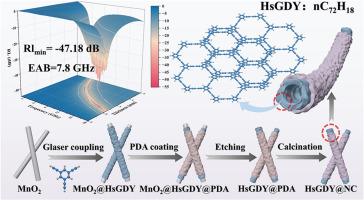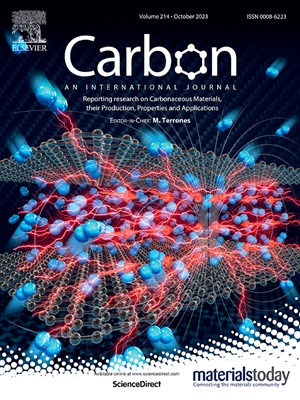Thickness-controlled HsGDY/N-doped double-shell hollow carbon tubes for broadband high-performance microwave absorption
IF 10.5
2区 材料科学
Q1 CHEMISTRY, PHYSICAL
引用次数: 0
Abstract
With the increasing deterioration of the electromagnetic environment, it is important to develop new and efficient electromagnetic wave-absorbing materials. In this work, bilayer hollow HsGDY/NC nanotubes with controllable thickness are constructed by introducing high conductivity polydopamine (PDA) and hydrogen-substituted graphdiyne (HsGDY) followed by the etching and carbonization. Subsequently, the effects of the composition, coating order, and structural characteristics of nanotubes on the electromagnetic parameters are thoroughly investigated, thereby analyzing the microwave absorption mechanism. The impedance matching of HsGDY/NC is optimized by changing the thickness of NC layer, while utilizing unique multi-heterogeneous interfaces and hierarchical conductive structures that enhance the interface polarization and conductive loss. As a result, HsGDY@NC-3 displays the optimal absorbing performance with an effective absorption bandwidth (EAB) of 7.8 GHz (10.1–17.9 GHz) and a minimum reflection loss (RLmin) of −47.18 dB at the filler content of only 11 %. This work broadens the application scopes of HsGDY and provides a novel insight into the design of lightweight, high-efficiency, and wide-frequency microwave absorbers, which is expected to be a potentially effective microwave-absorbing material.

厚度可控的 HsGDY/N 掺杂双壳空心碳管用于宽带高性能微波吸收
随着电磁环境的日益恶化,开发新型高效电磁波吸收材料显得尤为重要。在这项研究中,通过引入高导电率的聚多巴胺(PDA)和氢取代石墨二炔(HsGDY),然后进行刻蚀和碳化,构建了厚度可控的双层空心 HsGDY/NC 纳米管。随后,深入研究了纳米管的组成、涂层顺序和结构特征对电磁参数的影响,从而分析了微波吸收机理。通过改变 NC 层的厚度优化了 HsGDY/NC 的阻抗匹配,同时利用独特的多异质界面和分层导电结构增强了界面极化和导电损耗。因此,HsGDY@NC-3 显示出最佳的吸收性能,有效吸收带宽 (EAB) 为 7.8 GHz(10.1-17.9 GHz),在填料含量仅为 11% 时,最小反射损耗 (RLmin) 为 -47.18 dB。这项研究拓宽了 HsGDY 的应用范围,为轻质、高效、宽频微波吸收器的设计提供了新的见解,有望成为一种有效的微波吸收材料。
本文章由计算机程序翻译,如有差异,请以英文原文为准。
求助全文
约1分钟内获得全文
求助全文
来源期刊

Carbon
工程技术-材料科学:综合
CiteScore
20.80
自引率
7.30%
发文量
0
审稿时长
23 days
期刊介绍:
The journal Carbon is an international multidisciplinary forum for communicating scientific advances in the field of carbon materials. It reports new findings related to the formation, structure, properties, behaviors, and technological applications of carbons. Carbons are a broad class of ordered or disordered solid phases composed primarily of elemental carbon, including but not limited to carbon black, carbon fibers and filaments, carbon nanotubes, diamond and diamond-like carbon, fullerenes, glassy carbon, graphite, graphene, graphene-oxide, porous carbons, pyrolytic carbon, and other sp2 and non-sp2 hybridized carbon systems. Carbon is the companion title to the open access journal Carbon Trends. Relevant application areas for carbon materials include biology and medicine, catalysis, electronic, optoelectronic, spintronic, high-frequency, and photonic devices, energy storage and conversion systems, environmental applications and water treatment, smart materials and systems, and structural and thermal applications.
 求助内容:
求助内容: 应助结果提醒方式:
应助结果提醒方式:


